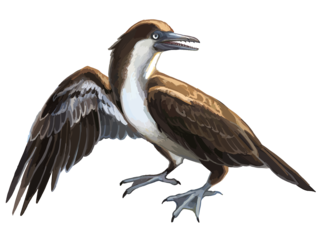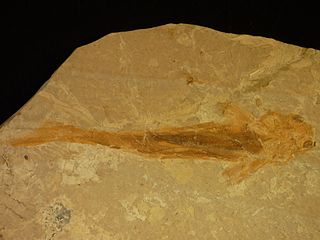Related Research Articles

Clupeiformes is the order of ray-finned fish that includes the herring family, Clupeidae, and the anchovy family, Engraulidae. The group includes many of the most important forage and food fish.

The Esociformes is a small order of freshwater ray-finned fish, with two families, Umbridae and Esocidae. The pikes of genus Esox give the order its name.

Acipenseriformes is an order of basal ray-finned fishes that includes living and fossil sturgeons and paddlefishes (Acipenseroidei), as well as the extinct families Chondrosteidae and Peipiaosteidae. They are the second earliest diverging group of living ray-finned fish after the bichirs. Despite being early diverging, they are highly derived, having only weakly ossified skeletons that are mostly made of cartilage, and in modern representatives highly modified skulls.

Carcharhiniformes, the ground sharks, are the largest order of sharks, with over 270 species. They include a number of common types, such as catsharks, swellsharks, and the sandbar shark.

Enchodus is an extinct genus of aulopiform ray-finned fish related to lancetfish and lizardfish. Species of Enchodus flourished during the Late Cretaceous, and there is some evidence that they may have survived to the Paleocene or Eocene; however, this may just represent reworked Cretaceous material.
Acipenser is a genus of sturgeons. With 17 living species, it is the largest genus in the order Acipenseriformes. The genus is paraphyletic, containing all sturgeons that do not belong to Huso, Scaphirhynchus, or Pseudoscaphirhynchus, with many species more closely related to the other three genera than they are to other species of Acipenser. They are native to freshwater and estuarine systems of Eurasia and North America, and most species are threatened. Several species also known to enter near-shore marine environments in the Atlantic, Arctic and Pacific oceans.
Asiamericana is a dubious genus of coelurosaur known only from isolated teeth found in the Bissekty Formation of Uzbekhistan. It was named to recognize the occurrence of similar fossil teeth in Central Asia and North America. These regions once formed a connected land mass, during the Cretaceous period.

Yanornis is an extinct genus of fish-eating Early Cretaceous birds. Two species have been described, both from Liaoning province, China: Yanornis martini, based on several fossils found in the 120-million-year-old Jiufotang Formation at Chaoyang, and Yanornis guozhangi, from the 124-million-year-old Yixian Formation.
The Xiagou Formation is the middle strata of the Xinminbao Group. It is named for its type site in Xiagou, in the Changma Basin of Gansu Province, northwestern China and is considered Early Cretaceous in age. It is known outside the specialized world of Chinese geology as the site of a Lagerstätte in which the fossils were preserved of Gansus yumenensis, the earliest true modern bird.

Lycoptera is an extinct genus of fish that lived from Lower Cretaceous, Barremian to Aptian in present-day China, North Korea, Mongolia and Siberia. Although there is record from Jurassic Formation in Siberia, its age remains questionable. It is known from abundant fossils representing sixteen species, which serve as important index fossil used to date geologic formations in China. Along with the genus Peipiaosteus, Lycoptera has been considered a defining member of the Jehol Biota, a prehistoric ecosystem famous for its feathered dinosaurs, which flourished for 20 million years during the Early Cretaceous, where it occurs abundantly in often monospecific beds, where they are thought to have died in seasonal mass death events. Lycoptera is a crown group teleost belonging to an early diverging lineage of the Osteoglossomorpha, which contains living mooneyes, arapaima, arowana, elephantfish and knifefish/featherbacks.

The Jehol Biota includes all the living organisms – the ecosystem – of northeastern China between 133 and 120 million years ago. This is the Lower Cretaceous ecosystem which left fossils in the Yixian Formation and Jiufotang Formation. These deposits are composed of layers of tephra and sediment. It is also believed to have left fossils in the Sinuiju series of North Korea. The ecosystem in the Lower Cretaceous was dominated by wetlands and numerous lakes. Rainfall was seasonal, alternating between semiarid and mesic conditions. The climate was temperate. The Jehol ecosystem was interrupted periodically by ash eruptions from volcanoes to the west. The word "Jehol" is a historical transcription of the former Rehe Province.
Mesoclupea showchangensis is an extinct ichthyodectiform ray-finned fish that lived in freshwater environments in what is now China during the Early Cretaceous epoch. It differs from its sister genus, Chuhsiungichthys, primarily by having a more posteriorly-placed dorsal fin.
Stichopterus is an extinct genus of chondrostean ray-finned fish that lived during the Early Cretaceous epoch in Asia. It has been found in Russia and Mongolia.

Koonwarria manifrons is an extinct species of ray-finned fish that lived in a polar lake in what is now Koonwarra, Victoria, Australia during the Early Cretaceous epoch. Fossils have been retrieved from the Strzelecki Group.
Pleuropholis is an extinct genus of prehistoric ray-finned fish.

Peipiaosteus is an extinct genus of prehistoric chondrostean ray-finned fish. Its fossils are found in the Early Cretaceous Jiufotang Formation, Pani Lake, Liaoning Province, China.

Longipterygidae is a family of early enantiornithean avialans from the Early Cretaceous epoch of China. All known specimens come from the Jiufotang Formation and Yixian Formation, dating to the early Aptian age, 125-120 million years ago.
Chuhsiungichthys is an extinct genus of ichthyodectiform ray-finned fish that lived in freshwater environments in what is now Yunnan, China, and Kyushu, Japan, during the Cretaceous. It differs from its sister genus, Mesoclupea, primarily by having a comparatively more anteriorly-placed dorsal fin.

Ginglymodi is a clade of ray-finned fish containing modern-day gars (Lepisosteidae) & their extinct relatives in the order Lepisosteiformes, the extinct orders Semionotiformes and Kyphosichthyiformes, and various other extinct taxa. Ginglymodi is one of the two major subgroups of the infraclass Holostei, the other one being Halecomorphi, which contains the bowfin and eyespot bowfin and their fossil relatives.
References
- 1 2 Alison M. Murray, Hai-Lu You & Cuo Peng (2010). "A new Cretaceous osteoglossomorph fish from Gansu Province, China". Journal of Vertebrate Paleontology . 30 (2): 322–332. Bibcode:2010JVPal..30..322M. doi:10.1080/02724631003621961. S2CID 84159091.


